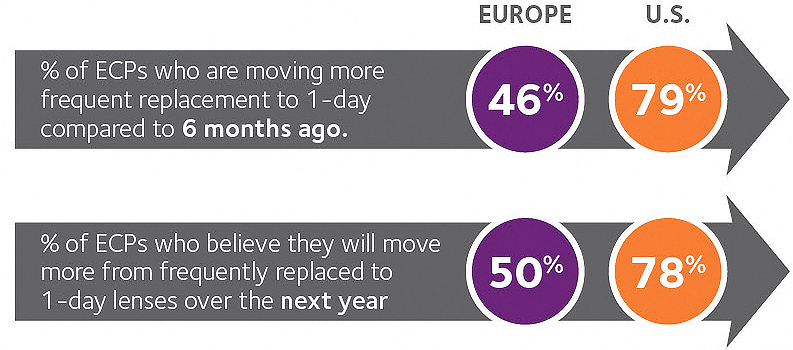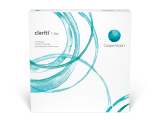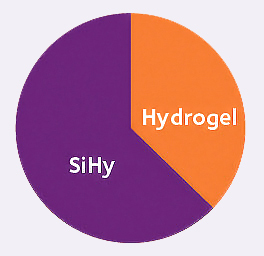
Moving frequent replacement contact lens wearers to 1 day lenses?
Be careful not to get lost along the way
Moving to 1 day lenses: don't get lost along the way
As technology evolves, so do the opportunities for how to make best use of any new features and benefits it may deliver. Contact lenses are no exception. Fitting practices change over time, driven by both new product availability and a growing evidence-base related to maximizing long-term healthy and comfortable wear. The modern contact lens wearer can hold the reasonable expectation of wearing lenses for many years. This is most likely achieved through their lenses being refit and optimized throughout that lifetime of wear. Given the move to increased use of 1 day lenses,1 those wearing frequently replaced (reusable monthly and 2-weekly replacement) options may find their eye care professional (ECP) recommends a change in modality to a fresh lens every day.
What exactly takes places when this refit is recommended is not well understood. Who is driving the change and why? How do ECPs and patients feel about the move? Which 1 day lenses are being prescribed? Taking responses from two continents, CooperVision® investigated these very questions. Both ECPs and contact lens wearers in the US and Europe (Germany, Spain, Italy and France) were surveyed, with the results leading to new insights in the important area of refitting from frequent replacement to 1 day lenses.
These insights clearly show the profession is doing many things correctly, and that those actions are corroborated by scientific evidence. However, the results also show the refitting into 1 day lenses is not always easy, with perceived price barriers often preventing silicone hydrogel technologies from being recommended.
This report reviews current fitting practice and reveals new insights from the survey. Through understanding ECP concerns, and patient expectations, it is possible not only to see where the disconnect is, but also to begin taking steps to address it.
| Popularity of silicone hydrogels |
76% | of all soft contact lens fits use silicone hydrogel materials.1 | |
82% | of frequent replacement contact lenses fit are silicone hydrogel materials.1 |
These figures illustrate the popularity of silicone hydrogel materials. Clearly this material is front of mind for ECPs when making their soft contact lens recommendations.
| Evidence for the performance of silicone hydrogels |
ECP preference for fitting silicone hydrogel over hydrogel is corroborated by evidence generated over their twenty year history. The benefits of wearing materials that can deliver more oxygen to the cornea than hydrogel materials are consistently reported.
Complications related to hypoxia such as neovascularisation and limbal hyperaemia are largely eliminated when these materials are worn on an extended,2-4 or daily wear basis.5 For daily wear, this means the ECP may not generally need to counsel their patient on restricting hours of use or be concerned for those wearing thicker designs such as torics. Patients benefit from a material which copes well with the long hours of wear that their busy lifestyles may demand.
| Growth in use of 1 day lenses |
Recommendation of 1 day lenses is increasing. Wide variation exists by market, ranging from a high of 71% in Denmark, to 4% in Mexico, but on average this modality accounts for one-third of all soft lens fits.1
1 day lenses deliver some obvious benefits for patients. Quick and convenient, with no need for daily cleaning or lens cases, and the flexibility to wear on a full or part time basis. ECPs also understand that in addition to these features, using a fresh lens each day confers clinical advantages. The incidence of corneal infiltrative events is significantly lower,6 with one study reporting a 12.5 times reduced risk compared to frequently replaced lenses.7
| The best of both worlds |
Given the evidence for the clinical performance of both silicone hydrogel materials and single use modality, it comes as no surprise that ECPs see the benefit of combining these features into one lens. When asked, around nine in ten ECPs agree that silicone hydrogel should be the first choice of material used in 1 day contact lenses, and that this lens is the best choice to help safeguard patient eye health.8 In fact when questioned, 7 out of 10 ECPs admit this is the type of lens they choose to wear themselves,9 and growth of 1 day silicone hydrogels was significantly higher than 1 day hydrogels in 2018 (35% vs 3%).10
While many patients will continue to be well suited to frequently replaced lenses, increasingly, and based on the perception of long-term ocular health, comfort and flexible wear, ECPs are recommending a move to a 1 day modality.11
NEW international eye care professional and contact lens wearer insights
A new, large-scale survey sheds light on the movement of frequent replacement to 1 day lenses. A total of 450 ECPs and 2000 contact lens wearers from Germany, Spain, Italy, France and the US were questioned about their experience.11
KEY INSIGHTS
1 | Refitting to 1 day lenses is becoming more common, and is driven by the ECP |
Refitting from frequent replacement to 1 day lenses is becoming more common. Around half of the European ECPs surveyed reported they have been switching more patients from frequently replaced to 1 day lenses over the last 6 months, with a similar proportion feeling that this trend will continue over the next year.11 In the US, these numbers were even higher.11

2 | Switch is driven by ECP, but patient is likely to agree with the recommendation |
84% | of the time it is the ECP who is driving the change.11 | |
69% | of patients report they make their decisions based on their ECP recommendation.11 |
3 | ECP reasons for change are related to eye health and comfort |
70% | of the time ECPs suggested the switch because patients had issues with their previous lenses.11 | |
The change in modality occurs for the following ECP perceived benefits of 1 day lenses: general and long-term eye health, comfort at the end of the day, and better fit for patient's lifestyle.11
4 | Getting "lost": not all patients moving from frequent replacement silicone hydrogels end up in the lens ECPs prefer to fit |
Nearly nine in ten ECPs agree that "like patients who wear frequent replacement lenses", they believe "those in 1 day lenses should be in a silicone hydrogel material."8 Importantly, this thinking aligns with what patients want. More than two-thirds of contact lens wearers say they expect their ECP to recommend – regardless of the cost – lenses that provide 100% of the oxygen their eye needs.12
Watchout! Upgrading the modality but reducing oxygen transmissibility.
Despite the positive trend in 1 day silicone hydrogel fitting, and ECP stated preference for the lens, it is surprising nearly half of patients moved from frequent replacement silicone hydrogel are fit with 1 day hydrogel materials.10
| ← | 4 in 10 |
Material used when refitting frequent replacement SiHy patients into 1 day lenses
5 | Reasons for ECPs using hydrogel rather than silicone hydrogel material when refitting patients |
| 55% of ECPs are prescribing 1 day hydrogel over silicone hydrogel due to the price.11 | |
| 28% of ECPs believe some patients do not wear their lenses enough to require the oxygen transmissibility benefit of silicone hydrogel.11 |
Although ECPs believe 1 day silicone hydrogel should be the first choice for patients, difficulties in communicating the price, and a lack of belief in the need for this material for part time wear results in hydrogel lenses being fit 40% of the time.
Overcoming the last hurdle and finding the way to help enable you to fit more of the lenses you would prefer to
1 day silicone hydrogel lenses have evolved considerably during their ten year history. Available in a wide choice of prescriptions and designs, good vision and fit performance and with reliable comfort performance,13 ECPs have few reasons not to reach for these lenses. The last remaining hurdle is price. This is particularly understandable when refitting a patient from frequent replacement to 1 day lenses. Most likely there will be an increase in cost to change to a 1 day modality, and the ECP needs to be able to justify that change. It is helpful to remember though that the ECP does have a choice within 1 day lenses of both hydrogel and silicone hydrogel materials that are at similar price points.
Naturally, it all comes down to communication and educating the patient so they can make an informed choice. Some tips to use in practice are outlined below
CLINICAL COMMUNICATION |
|
#1. Inform patients
The survey is an important reminder of low awareness among patients, with only one-third knowing about 1 day silicone hydrogels.11 However, around two-thirds of them are interested to learn more,11 which means ECPs should inform the patient of all their options, including 1 day silicone hydrogels.
#2. Use language that resonates
The most important factors for patients when choosing a contact lens are "all day comfortable wear" and "long-term eye health".11 Use these phrases, rather than leading with "oxygen", when explaining the benefits of silicone hydrogels.
#3. Reinforce silicone hydrogel benefits
The patient in silicone hydrogel frequent replacement lenses may have forgotten, or never been told of, the ocular health benefits of the material. It is important to reinforce that a 1 day silicone hydrogel brings together both modality AND material benefits.
WAYS TO THINK ABOUT THE PRICE
1. Remember, some 1 day silicone hydrogel options are priced similarly to 1 day hydrogel lenses
2. Use cost per wear,14 especially for part time wearers
3. No expenditure on care solutions or cases
4. Make use of manufacturer practice support tools that may help you communicate product benefits
ECPs and practice staff can use these tips to help ensure refitting from frequent replacement to 1 day does not get lost along the way.
Small changes will lead to significantly more patients wearing the lens that ECPs believe should be the first choice: a 1 day silicone hydrogel.

Reference:
1. Morgan P, Woods C, Tranoudis IG, et al. International Contact Lens Prescribing in 2018. Contact Lens Spectrum. 2019;34(January 2019):26-32.
2. Dumbleton KA, Chalmers RL, Richter DB, Fonn D. Vascular response to extended wear of hydrogel lenses with high and low oxygen permeability. Optometry and vision science. 2001;78(3):147-151.
3. Fonn D, MacDonald KE, Richter D, Pritchard N. The ocular response to extended wear of a high Dk silicone hydrogel contact lens. Clinical & experimental optometry. 2002;85(3):176-182.
4. Papas EB, Vajdic CM, Austen R, Holden BA. High-oxygen-transmissibility soft contact lenses do not induce limbal hyperaemia. Current eye research. 1997;16(9):942-948.
5. Morgan PB, Chamberlain P, Moody K, Maldonado-Codina C. Ocular physiology and comfort in neophyte subjects fitted with daily disposable silicone hydrogel contact lenses. Contact lens & anterior eye. 2012.
6. Chalmers RL, Hickson-Curran SB, Keay L, Gleason WJ, Albright R. Rates of adverse events with hydrogel and silicone hydrogel daily disposable lenses in a large postmarket surveillance registry: The TEMPO Registry. Investigative ophthalmology & visual science. 2015;56(1):654-663.
7. Chalmers RL, Keay L, McNally J, Kern J. Multicenter case-control study of the role of lens materials and care products on the development of corneal infiltrates. Optometry and vision science. 2012;89(3):316-325.
8. Orsborn G, Dumbleton K. Eye care professionals' perceptions of the benefits of daily disposable silicone hydrogel contact lenses. Cont Lens Anterior Eye, 101016/jclae201902012. 2019.
9. CooperVision study conducted by kublic llc in the U.S. August 2018. Total 1-day wearer sample size n=183. 2 Industry reports and internal estimates. Among 183 surveyed U.S. optometrists who wear 1-day contact lenses, 72% prefer a silicone hydrogel product for themselves. In:2018.
10. Industry reports and CooperVision data. 2018.
11. Basis. Migration from FRP to DD. Surveys conducted online in Q1 2019 in Europe (France, Germany, Italy, Spain) and the US. 75 eye care professionals (ECPs) in each European country, with French sample weighted to 75; 150 ECPs in the US, plus 500 consumers in each of Germany, Italy, Spain and the US who had switched from FRP to DD in the last 6 months, or who were open to using DD in future. CVI data on file 2019.
12. YouGov. Silicone hydrogel lenses. Total sample size was 1520 adults who wear contact lenses. Fieldwork undertaken Mar 26th-Apr 3rd 2018. Survey carried out online. In:2018.
13. Varikooty J, Schulze MM, Dumbleton K, et al. Clinical performance of three silicone hydrogel daily disposable lenses. Optometry and vision science. 2015;In press.
14. Efron N, Efron SE, Morgan PB, Morgan SL. A 'cost-per-wear' model based on contact lens replacement frequency. Clinical & experimental optometry. 2010;93(4):253-260.













